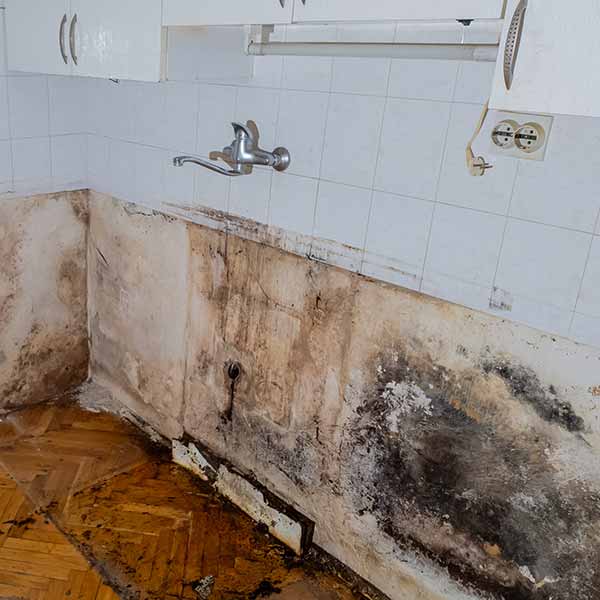
Mold Damage Remediation, Cleanup, and Removal near Metro Atlanta
Rapid Response
Day or Night

In Business
over 20 Years
Highly Rated
on Google!
- BBB A+ Rated
- Highly Rated on Google
- 24/7 Live Calls
- Free Estimates
- We Bill Your Insurance
- Locally Owned & Operated
Mold Removal Services
Mold becomes a problem inside a home or business when there’s excessive humidity or moisture for an extended period of time. The problem can originate from sudden water releases, like a burst pipe or large spill that goes untreated, or from a chronic condition, such as a leaking roof or plumbing. Even high humidity or warm, moist air condensing on cool surfaces can trigger mold problems. It’s always best to have the mold evaluated and removed by a certified professional like Water Pro, Inc.
Certified professionals at Water Pro Inc. have the training and experience to: identify moisture sources, evaluate mold growth (visible or suspected), to contain damage to the smallest area possible, to physically remove contamination, to dry materials to ensure that mold will not return, and to perform or recommend procedures for returning property to a pre-loss condition.

Introduction to Molds
Molds produce tiny spores to reproduce. Mold spores waft through the indoor and outdoor air continually. When mold spores land on a damp spot indoors, they may begin growing and digesting whatever they are growing on in order to survive.
There are molds that can grow on wood, paper, carpet, and foods. When excessive moisture or water accumulates indoors, mold growth will often occur, particularly if the moisture problem remains undiscovered or un-addressed. There is no practical way to eliminate all mold and mold spores in the indoor environment; the way to control indoor mold growth is to control moisture.
Mold can grow almost anywhere in a home or business if conditions permit. If there is visible growth on painted wall surfaces, property owners should be concerned about what may be growing on the wall’s opposite side. The environment inside the walls of a house often differs drastically from the outside and could create a perfect haven for mold.
If the wall remains wet for a prolonged period, it’s almost guaranteed that the mold growth on the backside will be worse than on the front. At that point, containing the workspace and removing moldy materials, followed by cleaning of salvageable framing, are the best options.
Nine things you should know about mold
- Potential health effects and symptoms associated with mold exposures include allergic reactions, asthma, and other respiratory complaints.
- If mold is a problem in your home or school, you must clean up the mold and eliminate sources of moisture.
- Fix the source of the water problem or leak to prevent mold growth.
- Reduce indoor humidity (to 30-60% ) to decrease mold growth by: venting bathrooms, dryers, and other moisture-generating sources to the outside; using air conditioners and dehumidifiers; increasing ventilation; and using exhaust fans whenever cooking, dishwashing, and cleaning
- Clean and dry any damp or wet building materials and furnishings within 24-48 hours to prevent mold growth.
- Clean mold off hard surfaces with water and detergent, and dry completely. Absorbent materials such as ceiling tiles, that are moldy, may need to be replaced.
- Prevent condensation: Reduce the potential for condensation on cold surfaces (i.e., windows, piping, exterior walls, roof, or floors) by adding insulation.
- In areas where there is a perpetual moisture problem, do not install carpeting (i.e., by drinking fountains, by classroom sinks, or on concrete floors with leaks or frequent condensation).
- Molds can be found almost anywhere; they can grow on virtually any substance, providing moisture is present. There are molds that can grow on wood, paper, carpet, and foods.
Asthma & Mold
Molds can trigger asthma episodes in sensitive individuals with asthma. People with asthma should avoid contact with or exposure to molds. One third to one half of all structures have damp conditions that may encourage development of pollutants such as molds and bacteria, which can cause allergic reactions — including asthma — and spread infectious diseases. The only way to get rid of the mold, is to completely dry the building.
Timely action
It is essential to remember that damage resulting from water is progressive. The longer the water flows or wet conditions exist, the more is absorbed and the greater is the recovery problem. Merely stopping the source of the incoming water does not stop further water damage, though it is an obvious and critical first step.
Servicing your mold damage, mold remediation and mold removal needs in the Metro areas. We use licensed subcontractors when necessary.

Why Choose Water Pro For Water Damage Restoration?
When choosing a fire damage remediation company, you want someone who can help you get your home back the way it was. Here’s why we’re your best call:
-
24/7 Emergency Service
-
Rapid Response
-
Certified Technicians
-
Advanced Equipment
-
Comprehensive Service
-
Insurance Coordination
Mold Remediation Near Metro Atlanta
We have many happy customers all around Atlanta, including cities like Acworth, Alpharetta, Ansley Park, Athens, Auburn, Austell, Berkeley Lake, Braselton, Buford, Cumming, Dacula, Decatur, Duluth, Dunwoody, Flowery Branch, Grayson, Johns Creek, Kennesaw, Lawrenceville, Lilburn, Loganville, Marietta, Milton, Monroe, Norcross, Peachtree Corners, Roswell, Sandy Springs, Smyrna, Snellville, Sugar Hill, Suwanee, Tucker, Winder, and more. If you need reliable water damage restoration, contact Water Pro today for fast, professional service.


